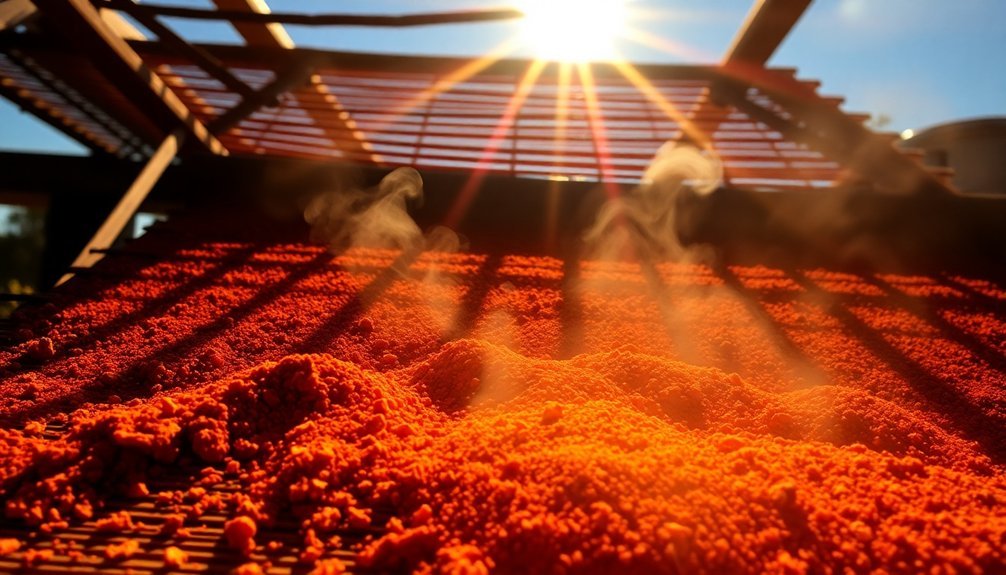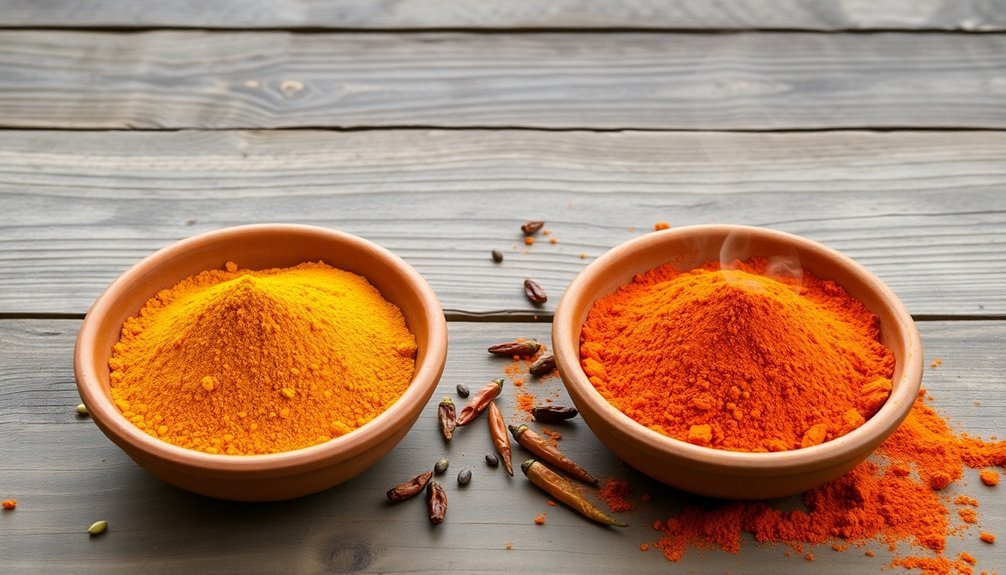Sun-dried curry spices taste different because they undergo a unique natural transformation when exposed to sunlight. You'll notice their flavors become more concentrated as the sun's heat gradually removes moisture while preserving essential oils and compounds. This slow drying process triggers chemical changes that can double the spiciness and enhance aromatic profiles, unlike artificial drying methods. The sun's rays also create secondary aroma compounds that add depth and complexity to the spices' taste. Traditional sun-drying techniques, passed down through generations, help develop distinct regional characteristics that you can't replicate with modern dehydration methods. There's more to discover about how sunlight transforms these aromatic treasures.
The Chemistry Behind Sun-Dried Spices

When spices undergo the sun-drying process, they experience complex chemical transformations that greatly alter their flavor profiles and potency.
You'll find that sun-drying can actually preserve certain beneficial compounds while triggering specific chemical reactions that enhance flavor intensity, similar to how gingerols transform into more potent shogaols.
Research shows that proper drying techniques can lead to significant differences in the final quality and biochemical properties of herbs and spices.
The method is particularly effective for preserving total polyphenol content and antioxidant capacity in spices like rosemary and peppermint.
However, you'll need to be strategic about extraction methods – if you're working with sun-dried spices, methanol-based extraction typically yields higher levels of beneficial compounds than ethanol.
When you're handling these spices, remember that grinding them releases volatile flavor molecules immediately, so it's best to process them just before use and fry them briefly in oil to maximize their flavor impact.
Natural Dehydration Process
The natural dehydration of spices marks a fundamental step in preserving their biochemical properties and enhancing their flavors. When you sun-dry curry spices, you'll benefit from a method that protects antioxidants and vitamins better than high-heat alternatives. The process doesn't require electricity or special equipment – just natural sunlight.
Sun drying maintains higher levels of total polyphenols and antioxidant capacity compared to oven drying at high temperatures. For example, fresh ginger undergoes a transformation where its gingerols become hotter during the drying process.
While it's slower than artificial drying methods, this traditional technique helps concentrate the spices' natural flavor compounds while preserving their delicate aromas.
You'll find that sun-dried spices retain more of their disease-fighting properties, and the gradual moisture reduction allows for chemical transformations that can actually intensify certain flavors, making your curry spices more potent and complex.
Solar Heat and Flavor Development

As sunlight gently warms your curry spices, complex chemical transformations enhance their flavor profiles and potency. You'll find that solar drying creates unique chemical changes, like turning gingerols in ginger into shogaols, which double the spiciness. The process releases more volatile compounds while preserving essential oils and aromatic elements.
When you use solar-dried spices, you're benefiting from a controlled drying environment that prevents overheating and maintains the spices' natural qualities. The method's particularly effective for developing regional characteristics – imagine the distinct flavors of cinnamon from Arunachal Pradesh or turmeric from Himachal Pradesh. Modern solar drying models like Sahaj and Samagra provide consistent results for small-scale spice producers.
Using advanced solar dryers, you'll get consistently high-quality results without damaging the delicate flavor compounds. For the best results, grind your dried spices just before use to maximize their aromatic impact.
Volatile Compounds and Sunlight
Understanding how sunlight affects volatile compounds offers deeper insights into the complexities of sun-dried spices. When you expose spices to sunlight, particularly UV rays, you'll trigger a process called autoxidation that transforms their essential oils. This can reduce oil content considerably – up to 45% in basil and 33% in marjoram.
Similar to microwave drying methods, research shows that temperature control plays a crucial role in preserving or altering volatile compounds in spices. You'll find that sunlight creates secondary aroma compounds like alcohols, aldehydes, and ketones, which change your spices' flavor profile.
The sun's heat combined with UV exposure breaks down cell walls and promotes chemical reactions that alter the volatile compounds. That's why you'll notice different tastes between sun-dried and alternatively dried spices.
The impact varies by spice type – some might develop enhanced flavors at certain temperatures, while others may lose their distinctive notes through volatilization.
Traditional Vs Sun-Dried Methods

While traditional spice preparation methods rely heavily on dry-roasting and oil-frying techniques, sun-dried approaches focus primarily on natural dehydration.
You'll find that traditional methods, like tadka, release complex flavors by heating spices in oil, often combining up to 25 different ingredients for rich, layered tastes.
Sun-drying, though simpler, creates concentrated flavors through moisture reduction.
You'll notice that sun-dried spices develop deeper, earthier notes compared to their fresh counterparts, but they might lack the intricate flavor profiles achieved through traditional roasting.
While both methods effectively preserve spices, traditional techniques offer more control over the final taste.
When you're cooking, you can use either type interchangeably, though you might need to adjust quantities since sun-dried spices tend to be more intense in flavor.
Proper Storage After Sun-Drying
To maximize the flavor of your sun-dried curry spices, you'll need to select airtight glass jars or metal tins that have secure, tight-fitting lids to prevent moisture and air exposure.
You can further extend your spices' shelf life by storing smaller portions in vacuum-sealed bags if you're planning to freeze them for long-term preservation.
Keep your containers in a cool, dark pantry away from heat sources, and make sure you're using dry utensils when measuring to maintain the spices' potency for up to three years.
Airtight Container Selection Guidelines
Selecting the right airtight container proves crucial for preserving sun-dried curry spices.
You'll want to choose containers made from non-reactive, non-porous materials that protect your spices from light, air, and moisture. Glass containers with tight-fitting lids are your best bet for home storage, while metal containers with protective coatings work well for larger quantities.
- Choose glass jars with secure, airtight lids to maintain flavor intensity
- Select dark or opaque containers to shield spices from harmful light exposure
- Opt for containers with wide mouths for easy scooping and cleaning
- Pick individual containers for each spice to prevent flavor mixing
- Confirm containers are completely dry before filling with sun-dried spices
When selecting your containers, avoid plastic options that might absorb flavors or react with the spices' essential oils.
Your container choice directly impacts how long your sun-dried curry spices maintain their distinctive taste.
Shelf Life Extension Techniques
Beyond choosing the right containers, mastering proper storage techniques considerably extends the life of your sun-dried curry spices.
You'll get the best results by storing your spices in a cool, dry environment between 50°F and 70°F, keeping humidity below 60%.
To maximize freshness, transfer opened curry powder to airtight glass or ceramic containers, avoiding plastic which can absorb odors.
Keep your spices away from direct sunlight and heat sources, preferably in a dark pantry.
For long-term preservation, you can freeze curry powder in vacuum-sealed bags, which maintains potency for up to two years.
Monitor your spices regularly for signs of degradation like clumping, discoloration, or loss of aroma.
When handling bulk purchases, divide them into smaller portions to minimize air exposure and prevent quality loss.
Frequently Asked Questions
How Long Can Sun-Dried Curry Spices Retain Their Peak Flavor?
You'll get peak flavor from sun-dried curry spices for about 2-3 years if you're storing them correctly in airtight containers at 50-70°F, away from light and moisture. After that, they'll start losing potency.
Can Rain Exposure During Sun-Drying Affect the Final Spice Quality?
Yes, rain exposure will considerably impact your spices' quality. You'll notice reduced flavor intensity, potential mold growth, and altered texture. It's essential you protect drying spices from rain to maintain their ideal characteristics.
Which Curry Spices Should Never Be Sun-Dried?
You shouldn't sun-dry delicate herbs like curry leaves, cilantro, and basil, as they'll lose their essential flavors. Also, avoid sun-drying spices with volatile compounds like asafoetida to preserve their unique properties.
Does Altitude Affect the Sun-Drying Process of Curry Spices?
Yes, altitude greatly affects your spices' sun-drying process. You'll need longer drying times at higher elevations due to lower air pressure, and you should monitor carefully to prevent case hardening or incomplete drying.
Can Sun-Dried Spices Be Safely Rehydrated for Specific Recipes?
Yes, you can safely rehydrate sun-dried spices by soaking them in hot water, broth, or oil. Just make sure you're using clean liquids and store any unused portions in the refrigerator to prevent spoilage.
In Summary
You'll notice that sun-dried curry spices have a distinct depth and complexity that comes from their natural dehydration process. The sun's heat helps concentrate flavors while preserving volatile compounds differently than artificial drying methods. To maintain these enhanced flavors, store your sun-dried spices in airtight containers away from light and moisture. When used properly, they'll bring an authentic, intense flavor to your curry dishes.





Leave a Reply